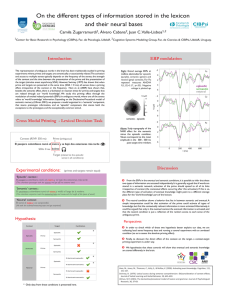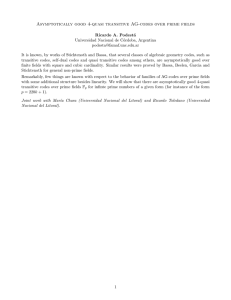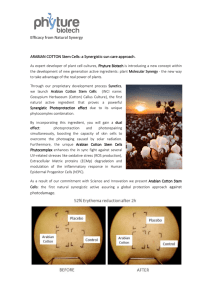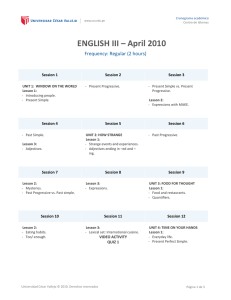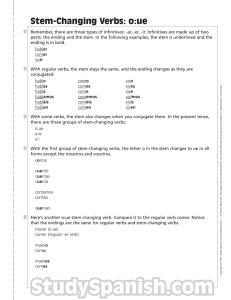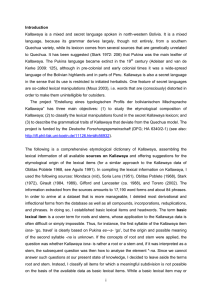Gender activation in transparent and opaque words
Anuncio
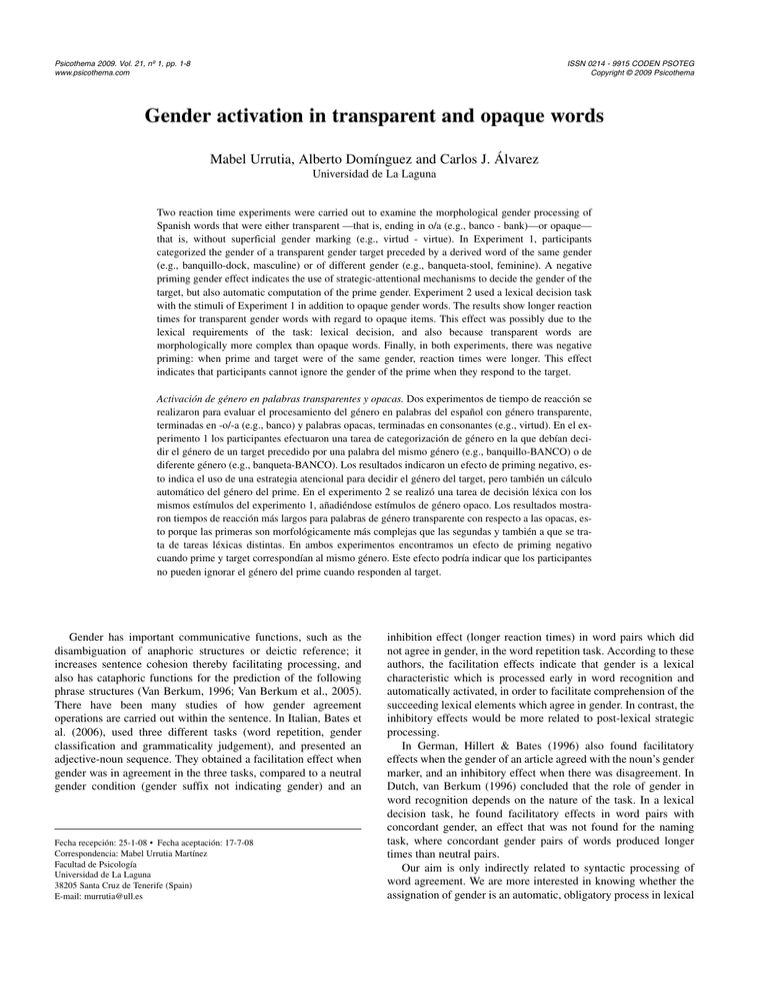
Psicothema 2009. Vol. 21, nº 1, pp. 1-8 www.psicothema.com ISSN 0214 - 9915 CODEN PSOTEG Copyright © 2009 Psicothema Gender activation in transparent and opaque words Mabel Urrutia, Alberto Domínguez and Carlos J. Álvarez Universidad de La Laguna Two reaction time experiments were carried out to examine the morphological gender processing of Spanish words that were either transparent —that is, ending in o/a (e.g., banco - bank)—or opaque— that is, without superficial gender marking (e.g., virtud - virtue). In Experiment 1, participants categorized the gender of a transparent gender target preceded by a derived word of the same gender (e.g., banquillo-dock, masculine) or of different gender (e.g., banqueta-stool, feminine). A negative priming gender effect indicates the use of strategic-attentional mechanisms to decide the gender of the target, but also automatic computation of the prime gender. Experiment 2 used a lexical decision task with the stimuli of Experiment 1 in addition to opaque gender words. The results show longer reaction times for transparent gender words with regard to opaque items. This effect was possibly due to the lexical requirements of the task: lexical decision, and also because transparent words are morphologically more complex than opaque words. Finally, in both experiments, there was negative priming: when prime and target were of the same gender, reaction times were longer. This effect indicates that participants cannot ignore the gender of the prime when they respond to the target. Activación de género en palabras transparentes y opacas. Dos experimentos de tiempo de reacción se realizaron para evaluar el procesamiento del género en palabras del español con género transparente, terminadas en -o/-a (e.g., banco) y palabras opacas, terminadas en consonantes (e.g., virtud). En el experimento 1 los participantes efectuaron una tarea de categorización de género en la que debían decidir el género de un target precedido por una palabra del mismo género (e.g., banquillo-BANCO) o de diferente género (e.g., banqueta-BANCO). Los resultados indicaron un efecto de priming negativo, esto indica el uso de una estrategia atencional para decidir el género del target, pero también un cálculo automático del género del prime. En el experimento 2 se realizó una tarea de decisión léxica con los mismos estímulos del experimento 1, añadiéndose estímulos de género opaco. Los resultados mostraron tiempos de reacción más largos para palabras de género transparente con respecto a las opacas, esto porque las primeras son morfológicamente más complejas que las segundas y también a que se trata de tareas léxicas distintas. En ambos experimentos encontramos un efecto de priming negativo cuando prime y target correspondían al mismo género. Este efecto podría indicar que los participantes no pueden ignorar el género del prime cuando responden al target. Gender has important communicative functions, such as the disambiguation of anaphoric structures or deictic reference; it increases sentence cohesion thereby facilitating processing, and also has cataphoric functions for the prediction of the following phrase structures (Van Berkum, 1996; Van Berkum et al., 2005). There have been many studies of how gender agreement operations are carried out within the sentence. In Italian, Bates et al. (2006), used three different tasks (word repetition, gender classification and grammaticality judgement), and presented an adjective-noun sequence. They obtained a facilitation effect when gender was in agreement in the three tasks, compared to a neutral gender condition (gender suffix not indicating gender) and an Fecha recepción: 25-1-08 • Fecha aceptación: 17-7-08 Correspondencia: Mabel Urrutia Martínez Facultad de Psicología Universidad de La Laguna 38205 Santa Cruz de Tenerife (Spain) E-mail: [email protected] inhibition effect (longer reaction times) in word pairs which did not agree in gender, in the word repetition task. According to these authors, the facilitation effects indicate that gender is a lexical characteristic which is processed early in word recognition and automatically activated, in order to facilitate comprehension of the succeeding lexical elements which agree in gender. In contrast, the inhibitory effects would be more related to post-lexical strategic processing. In German, Hillert & Bates (1996) also found facilitatory effects when the gender of an article agreed with the noun’s gender marker, and an inhibitory effect when there was disagreement. In Dutch, van Berkum (1996) concluded that the role of gender in word recognition depends on the nature of the task. In a lexical decision task, he found facilitatory effects in word pairs with concordant gender, an effect that was not found for the naming task, where concordant gender pairs of words produced longer times than neutral pairs. Our aim is only indirectly related to syntactic processing of word agreement. We are more interested in knowing whether the assignation of gender is an automatic, obligatory process in lexical 2 MABEL URRUTIA, ALBERTO DOMÍNGUEZ AND CARLOS J. ÁLVAREZ access. In other words, we want to explore if gender is identified on the basis of surface, prelexical information of the word, such as the presence of the suffixes -a/-o, or if, on the contrary, gender information is only retrieved at a postlexical stage when agreement between one word and the other has to be computed. In addition, another related goal is to examine the morphological changes in the lexical memory when a word with a specific gender is activated; for example: what other words from the same family are also activated? One characteristic of Spanish gender which is crucial for morphological word processing is the presence of surface gender markers: The suffixes -o/-a indicate masculine and feminine gender, respectively, for example with niño/niña (boy/girl). Words with these markers are gender-transparent. However, there are also many words of opaque gender because they do not end in a specific morpheme, for example, lápiz (pencil) or reloj (clock). This characteristic could force the language producer/comprehender to carry out different operations to assign the gender of the word, depending on if they are transparent or opaque. While the gender of transparent words can be processed superficially and prelexically (detecting the suffix -a/-o), the gender of opaque words would require lexical processing (Holmes & Seguí, 2004). These differences were supported by a recent study (Hernández et al., 2004), using functional magnetic resonance imaging (fMRI), where it was seen that there was an increase in brain activity for the opaque items as opposed to the transparent items in areas related to morphological processing, indicating a greater cognitive «effort» of agreement in this type of words to determine their gender. In the first experiment of our study, these transparent words were presented in a gender categorization task; opaque gender words were added in a second experiment using the lexical decision task. Our aims were to find out how the activation of a word with a specific gender (banco-bank) changes as a function of the previous presentation of another word derived from it, where the prime could have the same gender (banquillo-dock) or different gender (banqueta-stool). Furthermore, we expect these experiments to shed some light on the morphological organization of lexical memory, by providing data about the amount of activation received by words from the same morphological family (i.e., those sharing the same stem and differing in gender). Another aspect of this study is the use of derived words as primes (e.g., banquillo-banco). The morphological structure of these kinds of words is complex, as it is made up of a stem (banc-), a derivative suffix (-ill-) and finally an inflected suffix of gender (-o). There were three reasons to employ these types of words: First, because in most studies of gender processing, «simple» words have been used, with the gender suffix attached directly to the stem. Second, the percentage of derived words in Spanish is very high. And third, we wanted to explore if possible effects of shared stem and shared gender suffixes are simply additive (both morphological relations cause facilitation) or if, on the contrary, there is some kind of interaction between the two types of morphological overlap between words. Predictably, and based on previous studies, when a genderspecified word is presented there is additional activation of other lexical items which share the same stem and the same gender, while members of the same morphological family with the opposite gender will remain deactivated or even inhibited. (Hernández et al., 2004). In Experiment 1, a gender categorization task was used (Bates et al., 1996; Holmes & Seguí, 2004). Participants had to make a decision about the gender of the target words. Because this task necessarily involves the computation of gender, we hope to maximize the possible effects of the manipulated factors: shared or differing stem and gender agreement. Words with transparent gender (i.e., «a/o» suffixed) were presented as targets because they are the most common and secure way of marking gender: 99.87% of the forms finished in «O» are masculine words, and 96.30% of the forms finished in «A» are feminine words (Bergen, 1978). It indicates that there are some exceptions in Spanish like «mano», «moto», whose gender is masculine and vice versa «mapa», «dogma» with feminine gender. As previously mentioned, the assignment of gender can be carried out strategically (by simply attending to the end of the word and determining if they see an -a or an -o). Therefore, in Experiment 2, we compared both transparent and opaque words in a lexical decision task. Our results will depend on how automatic the gender assignment processes is, the prelexical or postlexical level at which the cognitive assignment of gender is produced, and also on the specific task demands. If the results are the same with both tasks, we think that this will provide evidence for automatic gender processing at a lexical or prelexical stage, and not at a postlexical stage. EXPERIMENT 1 Method Participants 40 undergraduate students from the first year of Speech Therapy at the University of La Laguna participated in this experiment in order to obtain extra course credit. All were native speakers of Spanish, with normal or corrected-to-normal vision. The age range was 18-25 years. Materials and design Sixty nouns were selected as targets. All of them had transparent gender, ending in -o/-a. Half of them were feminine and half were masculine words. These target words were equivalent in length, with a minimum of two and a maximum of three syllables. The mean number of letters was 5.16 and the mean word frequency was 111.18 per million according to Alameda & Cuetos (1995). Mean maginability was 4.4270 (Davis & Perea, 2005). For each of the targets, four words were selected according to a 2×2 experimental design. The first factor, Gender Agreement, had two levels: same and different (prime and target), and the second factor, Stem, referred to the pairs of words which could have the same stem (being the prime a derived word and the target a word without a derivative suffix) or a non-related word (when the stem was not shared). Thus, each target was paired with four primes, for example, the target BANCO (bank) was paired with the prime banquillo (dock) in the same gender/same stem condition; with the prime listillo (little smart) in the same gender/different stem condition; with the prime banqueta (stool) in the different gender/same stem condition, and finally, with the prime coleta (pigtail) in the different gender/different stem condition. 3 GENDER ACTIVATION IN TRANSPARENT AND OPAQUE WORDS The stimuli were counterbalanced so that each participant saw 15 word-word pairs in each one of the four experimental conditions. Thus, all the participants went through all the conditions but saw each target only once. The presentation of the word pairs was random to avoid the use of predictive strategies in the gender categorization task. Procedure The participants carried out the experiment individually in sound-proofed booths. The experiment was run using the DmDx software (Forster & Forster, 2003). Each participant received training with seven stimuli before the 60 experimental trials and 60 additional opaque targets fillers were presented to avoid the use of a direct strategy of «look at the end and decide gender». Since lexical factors such as length, frequency and imaginability were not controlled, comparisons between opaque and transparent words were not possible. Each trial began with a 500 ms fixation point in the centre of the computer screen, which was then replaced by the stimulus. The prime was presented for 250 ms and was then immediately replaced by the target stimulus. All the prime words were presented in lower case letters while the targets were presented in capital letters to avoid possible iconic or sensory memory effects. The participant’s task was to pay attention to the two words presented and answer only about the second. The participants were instructed to answer as quickly and accurately as possible whether the gender of this word was feminine or masculine. The response was made by pressing one of two buttons on a «Logitech Gamepad» response device, with a loss of approximately 1ms. Possible handedness effects were controlled for by counterbalancing the response buttons. Results The mean reaction times and percentage of errors for each condition are shown in Table 1. All items with a reaction time above 2 seconds and with a mean error rate more than 50% were eliminated. In total, 0.62% of the data were eliminated (15 items). An ANOVA of the response latencies for the correct answers revealed a significant effect for participants and marginally for items of the first factor, Gender Agreement, (F1(1,39)= 3.96, Mse= 2823.76, p<.05; F2(1,59)= 3.40, Mse= 4228.74, p= .07): There was a significant inhibition of the response in those words preceded by words of the same gender. Furthermore, there was a significant facilitation in the responses to words preceded by primes with the same stem (F1(1,39)= 8.39, Mse= 3288.04, p<.001; F2(1,59)= 8.55, Mse= 5237.15, p<.001). The analysis on error rates showed no significant effects. Discussion The stem facilitation effect indicates that there is a processing benefit for the targets which are preceded by another word with the same stem. This priming effect has been dissociated from purely formal or semantic effects in other languages (Feldman, 2000; Drews & Zwitserlood, 1995; Rastle et al., 2000) as well as in Spanish (Domínguez et al., 2002; Sánchez-Casas et al., 2003), although we have not done this in this study, as this was not our main objective. The gender factor (same/different) produced a very surprising result. As we have seen, readers take less time at the task when the target has a different gender in both words. A first conclusion is that the mere presentation of the prime produces a computation of the gender even when the task does not demand this operation. Only the target gender should be computed to accomplish adequately the task. On the other hand, the negative priming effect would seem to indicate that gender assignment is carried out superficially, without accessing the lexicon, and as a consequence of an attentional mechanism. To determine the gender of a word, it is sufficient to pay attention to the end of the word and to decide if it ends in -a or -o for feminine or masculine, respectively. However, it seems that to do this, is necessary to inhibit the gender of the prime, as it is irrelevant. It is during this inhibition that the negative priming probably takes place. It is true that the negative gender priming effect may be a strategic task-induced effect. Additionally, it is important to note that we are forcing the participants to use their metalinguistic knowledge. If we use a task that does not focus the participants’ attention on the gender of the word, such as a lexical decision task, we should obtain facilitation in those pairs which share gender. Since we have taken the negative gender priming to imply an automatic computation of gender, the use of lexical decision task would provide evidence that gender is a characteristic which is automatically processed. Therefore, at a lexical level, the activation of a word of a particular gender makes this gender more available for other word of the same morphological family, thus speeding response times. EXPERIMENT 2 This experiment attempts to examine the gender effect obtained in Experiment 1 with a lexical decision task, a task which does not focus on the metalinguistic knowledge of the reader, and should therefore reduce confounding effects due to strategic mechanisms of attention. An additional objective was the introduction of a new variable, transparency, by including targets which have alternative or gender-opaque endings, such as VIRTUD, to test whether or not the effect of the gender variable is independent of the presence or absence of a superficial mark such as the suffixes -o/-a. Table 1 Mean reaction times and percentage of errors (in parentheses) in Experiment 1 with a Gender categorisation task Target BANCO Gender Stem RT (% err) Same Same Different 856 (4.66) banquillo 883 (4.83) listillo Different Same Different 840 (4.33) banqueta 865 (4.33) coleta Method Participants 46 students from introductory Psychology courses participated voluntarily in order to obtain course credits. They were all native speakers of Spanish with normal or corrected-to-normal vision. The age range was 18-25 years. 4 MABEL URRUTIA, ALBERTO DOMÍNGUEZ AND CARLOS J. ÁLVAREZ Materials We selected 120 nouns as targets. Sixty of these had transparent gender, ending in -o/-a, and were exactly the stimuli of the experiment 1. The other 60 words had opaque gender. Half were feminine words and half were masculine. The mean number of letters was 5.65 for the opaque words, a lexical frequency of 110.03 and a mean of 4.26 for imaginability. No statistical difference was found between opaque words and transparent words (see appendix with means for opaque and transparent words). For each of the targets, e.g., VIRTUD-VIRTUE, four derived words were selected like primes: same gender and same stem e.g. virtuosa-virtuous woman; different gender and same stem e.g. virtuoso-virtuous man; same gender and different stem e.g. tramposa-cheat woman and different gender and different stem e.g. tramposo-cheat man. Design A 2×2×2 experimental design was used. The first factor, Transparency had two levels: Transparent gender and opaque gender. The second factor, Gender, also had two levels: Same and different (prime and target) and the third factor, Stem, referred to the pairs of words which could have the same stem (with the prime a derived word and the target a word without a derivative suffix) or a non-related word (when the stem was not shared). Thus, each target was paired with 4 primes. A set of one hundred pairs of word/pseudoword were added as fillers (there were 20 fewer fillers than the word/word pairs in order to shorten the experiment and avoid fatigue and inattention of participants). Half of the pseudoword foil targets ended in -a/o and the other half had different endings. The primes of the wordpseudoword pairs were selected in such a way that it was not possible to give a lexical decision response based on the presence or absence of relationships between the prime and target. Thus, we used 25 derived transparent words which shared initial letters with the pseudoword targets (e.g., Dudoso-DURSO), 25 derived transparent words which did not share any other letters with the target, except that both ended in -o/a (e.g. Mímica-PLABA), 25 derived opaque words which shared initial letters with the pseudoword targets (e.g. blancor-BLUSE) and 25 derived opaque words which were not orthographically related to the target (e.g. invasor-PITERAL). participants took longer to decide about the transparent words (704ms) than about the opaque words (689ms). This effect was significant only by subjects [F1(1,45)= 10.76, Mse= 1843.96, p<.01; F2>1]. In the case of the variable Stem, the ANOVA indicates that when words belong to the same morphological family, target recognition benefits from the previous semantic processing of the prime. (F1 (1,45)= 111.10, Mse= 1872.53, p<.001; F2 (1,118)= 55.92, Mse= 5362.26, p<.001). The variable Gender Agreement only yielded significant effects by items (F1 (1,45)= 1.92,Mse= 4348.39, p= .17; F2 (1,118)= 4.40, Mse= 2796.29, p<.05). This effect is modulated by a triple interaction of transparency x gender agreement x stem (F1 (1,45)= 5.36, Mse= 2266.94, p<.05; F2 (1, 118)= 5.35, Mse= 2772.08, p<.05). Further separate ANOVAs were carried out for transparent and opaque words. A significant effect of the variable Gender Agreement in transparent words was found (F1(1,45)= 6.11, Mse= 2619.95, p<.05; F2(1,59)= 5.92, Mse= 3562.51, p<.05), but not in opaque words. That is, there is an inhibition effect as in the previous experiment. This effect is modulated by the interaction of gender agreement x stem (F1(1,45)= 7.41, Mse= 1892.33, p<.01; F2(1,59)= 6.86, Mse= 2333.82, p<.05). Inhibition is greater when prime and target have the same gender, but different stems. On the other hand, the factor Stem yielded significant facilitation in both, transparent words (F1(1, 45)= 40.75, Mse= 1740.64, p<.001; F2(1,59)= 27.18, Mse= 3903.90, p<.001), and opaque words (F1(1,45)= 74.47, Mse= 1925.57, p<.001; F2(1,59)= 29.51, Mse= 6820.61, p<.001). Error analyses showed only a significant effect of Stem (F1(1,45)=18.28, Mse=20.97, p<.001, F2(1,118)=5.93, Mse=1.10, p<.05): participants had more errors when the stem of the prime differed from that of the target. Discussion The first important result was that transparent words produced longer reaction times than opaque words. The most plausible explanation for this is that words such as virtud-virtue or relojclock, which we have termed gender-opaque, are generally monomorphemic, that is, they need no type of segmentation or separation of morphemes as there is only one morpheme involved. In contrast, words ending in -o/a such as banco-bank are inflected words, with a gender suffix. In terms of morphological analysis, Procedure The same as in the previous experiment except that the participants had to decide whether the target was a word or a nonword. As in experiment 1, participants received 7 training items before the 120 experimental items which were randomised with the 100 word-pseudoword pairs. Table 2 Mean reaction times and percentage of errors (in parentheses) in Experiment 2 with a Lexical decision task Transparency Transparent Target Gender Stem RT (% err) BANCO Same Same Different 685 (3.47) banquillo 741 (5.07) listillo Different Same Different 683 (2.17) banqueta 705 (4.63) coleta Same Same Different 664 (4.05) virtuosa 714 (5.79) tramposa Different Same Different 658 (3.04) virtuoso 720 (5.36) tramposo Results The mean reaction times, as well as the percentage of errors in each experimental condition, are shown in Table 2. The total percentage of errors was 3.55. Items which had a response time above 2 seconds were eliminated (0.27% of the data). Repeated measure ANOVAs on the response times to the correct answers were run. A significant effect of transparency was found: The Opaque VIRTUD GENDER ACTIVATION IN TRANSPARENT AND OPAQUE WORDS these words are more complex than the opaque words. Monomorphemic words would then be represented in memory in a whole-word form and accessed directly, while transparent words would have a stem representation in the lexical memory and a separate analysis of the gender suffix will be carried out. The task required consulting the lexicon before deciding. This could be why reaction times to opaque words were longer in this experiment. In the second experiment, however, the negative gender priming effect was also observed, confirming the results of Experiment 1: When the prime and target were of the same gender, the reaction times were longer. This effect was observed only in the transparent and not in the opaque words. However, in Experiment 2 we did not ask the participants to make metalinguistic decisions about the gender of the word, or to direct their attention to the suffixes. Thus, a strategic (conscious) explanation of the negative priming effect can be ruled out. It seems, rather, that gender is a characteristic of the word that is automatically processed. This interference effect occurs when one word precedes another with the same gender only if gender is detected by applying a rule such as the -o/-a masculine-feminine rule. In addition, this inhibition was greater when primes and targets do not share the same stem. It is likely that the inhibition due to a shared gender suffix was reduced because of facilitation from a shared stem. General Discussion Two experiments were carried out with different tasks: gender categorisation and lexical decision. The categorisation task in Experiment 1 allowed participants to make a superficial analysis based on word-ending of the transparent stimuli. This attentiondependent strategy produced a negative effect on the target gender determination, probably due to the previous presentation of a similar gender prime. The observed stem priming effect suggests morphological processing of words. «In the lexical decision task, used in Experiment 2, opaque words were added in order to compare transparent and opaque words. Factors such as frequency, length and imaginability were controlled (see Alija & Cuetos, 2006 for comparison between main lexical variables). As the lexical decision task requires processing at the lexical memory level, reaction times were faster when the word was less morphologically complex (opaque) monomorphemic words such as virtud (virtue), than in a transparent condition with morphologically complex gender suffixes. On the other hand, in line with the results of Experiment 1, the negative priming for pairs of words with the same gender was replicated in the transparent words. However, this effect was not obtained when the words were gender opaque. In general, reaction times in the two experiments were much longer in the gender categorisation task than in the lexical decision task, which implies a higher cognitive cost for the first task. As mentioned above, the gender-categorisation task is a metalinguistic task that is very different from what normally occurs during reading. However, we think that the results provide important clues about the role of superficial orthographic information in gender assignment. The stem effect in Experiment 1 indicates that a morphological segmentation of the word, separating the suffix from the stem, is actually being carried out. The effect of negative priming is not 5 only an attentional effect, but also provides information about the resources that participants are spending when they are reading the prime. The categorization task does not demand any operation on the prime, however, the negative priming effect denotes that the reader is paying attention to the prime gender. If this were not the case, no negative priming would be produced. The lexical decision task used in Experiment 2 may provide better information about what is happening in the lexicon without asking the participant for any morphological information. The participants took more time to decide if a stimulus is a word when it was gender-transparent, such as mito, than when it was genderopaque, such as reloj. We think that this result points to a lexical access mechanism which was not required for the gender categorisation task (in Experiment 1). The existence of -a/o suffixes does not provide any kind of information about whether the stimuli is a word or not. The need to access the lexicon for all the stimuli, and the fact that the transparent words are morphologically complex, results in longer reaction times in response to these stimuli. The processing of opaque words produced similar reaction times in a study with a task similar to ours, carried out by Hernández et al. (2004), with fMRI. Their results showed that brain activity was greater in areas B44/45 of the left hemisphere when participants read opaque words. It is known that these areas are particularly activated when the task consists in producing the article or determiner of a given noun (Heim et al., 2002). This «syntactic» operation was defended also by Holmes & Seguí (2004) applied to opaque gender words. One other interesting effect is the inhibition produced in the pairs of same-gender words (masculine-masculine or femininefeminine), which occurred in both tasks and which was only significant when the target word ended in a suffix -o/a. This is the effect that some authors have termed Negative Priming (Ortells & Tudela, 1996; Tipper, 1985; Versace & Allain, 2001), and is a strategic attentional effect (Macizo, Bajo, & Soriano, 2006). As in these experiments, the prime presentation time is sufficient for conscious recognition, the participant cannot avoid recognising the gender of the prime. However, this does not result in any processing benefits, as the gender of the prime can coincide or not with that of the target. Thus, the task requires inhibiting the gender of the prime because the gender cannot be ignored. If prime and target have differing genders, this has no effect on the reaction times. However, if the gender of the two words is the same, and the reader has inhibited the gender of the prime, then there is an increase in the categorization time of the target. When the prime is a derived word from the target (and shares the stem with the last), however, this gender-based inhibition is reduced because the facilitation produced by the activation of those words of the same morphological with the same stem, as suggested by results of Experiment 2. Facilitation and inhibition effects for gender congruency varied according to language and to the kind of task used. Friederici & Jacobsen (1999), postulate that facilitation effects are more variable than inhibition effects. The formers are associated to phonological influence since the presentation of stimuli was auditory, such as in French and Italian (For a detailed review on gender across languages, see Friederici et al., 1999). Contrary to the behaviour of facilitation effects, inhibition effects are observed regardless of the types of tasks and languages and they are explained by the assumption of a intralexical model, which connects both given information of prime and target. 6 MABEL URRUTIA, ALBERTO DOMÍNGUEZ AND CARLOS J. ÁLVAREZ In summary, our most important finding is that the gender of the prime is processed in an automatic and obligatory way, whether or not this is relevant to task completion. Secondly, conflict only arises between the prime and target if the gender is represented in the word transparently and explicitly by a suffix (-o/a), and not when there is no gender marker at this surface level. This means that negative priming is not the result of mere inhibition of response when two stimuli are similar, but due to the processing of the gender which is only obligatory when this is marked by a typical suffix. Acknowledgement This study was financed by project SEJ2004-03775 and SEJ2007-66860 from the Ministerio de Educación y Ciencia. Appendix 1 Transparent Gender SAME Related Non related DIFFERENT Related Non related TARGET Length Frequency Imaginability Pescadería Astrónomo Galantería Hilillo Gotera Banquillo Ventanilla Friolero Camilla Abrigado Puntería Carretero Casona Zapatero Tecleada Abusivo Velada Milagrero Balística Mítico Poética Bañado Maniática Labializado Palabrería Trabajoso Firmada Añejo Minita Usuario Ideología Peligroso Pedrada Cristiano Joyería Frutero Lunática Ganadero Escénica Fiscalizado Peluquería Asqueroso Musiquilla Pasarela Mantilla Hechicero Flechada Pañuelo Palmera Cursillo Vitalicia Caballero Culposa Librito Cabecera Polvoriento Gallinita Jarrito Fantástica Colegiado Cafetería Fisónomo Enfermería Rabillo Playera Listillo Cocinilla Perchero Astilla Amparado Notaría Pordiosero Patrona Ganadero Aparcada Sorpresivo Soñada Curandero Lingüística Caótico Hermética Pintado Dinámica Estudiantado Conserjería Infeccioso Pedida Pendejo Casita Aulario Patología Apestoso Granizada Anciano Romería Llavero Simpática Cocinero Auténtica Estimulado Genealogía Belicoso Lamparilla Clientela Bombilla Pastelero Cansada Señuelo hornera Librillo Pericia Jornalero Odiosa Cojito Ranchera Harapiento Sonrisita Pepito Rústica Asociado Pescador Astrología Galanteo Hilacha Gotero Banqueta Ventanuco Friolera Camastro Abrigada Puntero Carretera Casero Zapatería Tecleado Abusona Velado Milagrosa Balístico Mítica Poético Bañera Maniático Labializada Palabrerío Trabajosa Firmado Añeja Minero Usuaria Ideólogo Peligrosa Pedrusco Cristiana Joyero Frutera Lunático Ganadería Escénico Fiscalizada Peluquero Asquerosa Musicalizado Pasillo Manteo Hechicera Flechazo Pañoleta Palmero Cursada Vitalicio Caballería Culposo Libreta Cabecero Polvareda Gallinero Jarrita Fantástico Colegiada Aviador Teología Devaneo Borracha Arquero Coleta Caduco Pradera Hijastro Cuchillada Casillero Pordiosera Perchero Heladería Aparcado Cuarentona Soñado Olorosa Lingüístico Caótica Hermético Obrera Dinámico Hospitalizada Caserío Maliciosa Pedido Pareja Casero Agraria Fisiólogo Apestosa Negruzco Anciana Romero Soltera Simpático Carpintería Auténtico Estimulada Hormiguero Belicosa Señalizado Rojillo Acarreo Pastelera Tortazo Corneta Coletero Apagada Ejercicio Peluquería Odioso Maleta Ranchero Alameda Curandero Pepita Rústico Asociada PESCA ASTRO GALA HILO GOTA BANCO VENTANA FRÍO CAMA ABRIGO PUNTA CARRO CASA ZAPATO TECLA ABUSO VELA MILAGRO BALA MITO POESÍA BAÑO MANÍA LABIO PALABRA TRABAJO FIRMA AÑO MINA USO IDEA PELIGRO PIEDRA CRISTO JOYA FRUTO LUNA GANADO ESCENA FISCO PELUCA ASCO MÚSICA PASO MANTA HECHIZO FLECHA PAÑO PALMA CURSO VIDA CABALLO CULPA LIBRO CABEZA POLVO GALLINA JARRO FANTASÍA COLEGIO 5 5 4 4 4 5 7 4 4 6 5 5 4 6 5 5 4 7 4 4 6 4 5 5 7 7 5 3 4 3 4 7 6 6 4 5 4 6 6 5 6 4 6 4 5 7 6 4 5 5 4 7 5 5 6 5 7 5 8 7 15 4 20 40 24 52 163 131 206 40 65 24 888 17 5 10 27 43 11 74 114 74 19 12 255 351 23 332 36 126 236 68 89 0 6 28 80 29 91 1 1 23 149 289 24 4 8 13 19 75 1147 94 77 286 418 69 19 3 40 84 5,3 -1 3,5 6,37 6,08 5,68 6,49 -1 7 6,72 5,23 5,96 6,46 5,64 5,33 4,47 5,71 3,11 5,61 3,11 5,57 6,35 3,87 6,7 5,21 5,09 5,91 3,65 5,36 2,86 3,72 4,47 6,21 -1 5,96 5,75 5,57 5,83 4,51 -1 -1 5,17 5,21 4,51 5,62 -1 6,15 4,87 6,42 2,8 3,8 6,61 3,54 6,21 6,01 5,8 6,71 -1 3,83 -1 5.16 111.18 4.427 Mean 7 GENDER ACTIVATION IN TRANSPARENT AND OPAQUE WORDS Appendix 2 Opaque Gender SAME Related Non related DIFFERENT Related Non related TARGET Lechera Cafetero Florita Cristalero Ciudadana Lapicero Urbana Heroico Mujercita Relojero Cancioncilla Robótico Moralizada Sonido Cruzada Pececillo Careta Carbonero Tijeritas Jaboncito Salada Movilizado Señalada Planificado Imaginaria Cartonero Gentuza Hambriento Razonada Limonero Mentalizada Camionero Funcionaria Alámbrico Carnicería Farolero Sangría Goleado Liberada Papeleo Reunida Gasoducto Crucificada Canceroso Basada Clonado Virtuosa Azucarado Cognitiva Cosmológico Confesada Alcohólico Revolucionaria Mensajero Religiosa Jardinero Conectada Marinero Cuestionada Terrorífico Manera Verdadero Pintita Hormiguero Avellana Embustero Humana Plástico Pobrecita Basurero Muletilla Idéntico Sintonizada Quejido Pelada Cuadernillo Paleta Delantero Sodomitas Hombrecito Dorada Canonizado Conectada Sacrificado Solidaria Forastero Caperuza Avariento Acostada Altanero Humanizada Aduanero Temeraria Volcánico Abogacía Santero Alegría Armado Asombrada Muestreo Letrada Viaducto Legalizada Tenebroso Calzada Marcado Tramposa Normalizado Nutritiva Etimológico Divertida Xenofóbico Universitaria Placentero Bondadosa Carcelero Manchada Cocinero Invertida Pacífico Lechero Cafetera Florito Cristalera Ciudadano Lapicera Urbano Heroica Mujeriego Relojería Cancionero Robótica Moralizado Sonajera Cruzado Pecera Careo Carbonera Tijeretazo Jabonera Salado Movilizada Señalado Planificada Imaginario Cartonera Gentío Hambrienta Razonado Limonada Mentalizado Camioneta Funcionario Alambrada Carnicero Farolera Sanguíneo Goleada Liberado Papelera Reunido Gasolina Crucificado Cancerosa Basado Clonada Virtuoso Azucarera Cognitivo Cosmografía Confesado Alcohólica Revolucionario Mensajera Religioso Jardinera Conectado Marítima Cuestionado Terrorífica Trastero Verdadera Dedito Bananera Avellano Embustera Humano Plástica Andariego Pedantería Refranero Idéntica Sintonizado Lisonjera Pelado Casera Pareo Delantera Escopetazo Billetera Dorado Canonizada Conectado Sacrificada Solidario Forastera Hastío Avarienta Acostado Encerada Humanizado Libreta Temerario Escapada Manicero Santera Fulmíneo Armada Asombrado Consejera Letrado Marihuana Legalizado Tenebrosa Calzado Marcada Tramposo Borrachera Nutritivo Ortografía Divertido Xenofóbica Universitario Placentera Bondadoso Carcelera Manchado Legítima Invertido Pacífica LECHE CAFÉ FLOR CRISTAL CIUDAD LÁPIZ URBE HÉROE MUJER RELOJ CANCIÓN ROBOT MORAL SON CRUZ PEZ CARA CARBÓN TIJERAS JABÓN SAL MÓVIL SEÑAL PLAN IMAGEN CARTÓN GENTE HAMBRE RAZÓN LIMÓN MENTE CAMIÓN FUNCIÓN ALAMBRE CARNE FAROL SANGRE GOL LIBERTAD PAPEL REUNIÓN GAS CRUCIFIXIÓN CÁNCER BASE CLON VIRTUD AZÚCAR COGNICIÓN COSMOS CONFESIÓN ALCOHOL REVOLUCIÓN MENSAJE RELIGIÓN JARDÍN CONEXIÓN MAR CUESTIÓN TERROR Mean Length Frequency Imaginability 5 4 4 7 6 5 4 5 5 5 7 5 5 3 4 3 4 6 6 5 3 5 5 4 6 6 5 6 5 5 5 6 7 7 5 5 6 3 8 5 7 3 11 6 4 4 6 6 9 6 9 7 10 7 8 6 8 3 8 6 69 105 59 74 332 10 2 39 668 71 44 19 171 1449 55 30 315 25 4 9 30 13 75 43 203 19 299 65 275 6 86 13 139 7 118 9 216 4 186 198 34 40 5 24 107 1 47 25 0 14 16 38 52 43 70 93 16 222 150 51 6,33 5,2 6,25 5,69 6,19 5,92 -1 5,68 6,61 6,04 5,33 6,07 2,07 -1 -1 6,76 6,25 6,06 6,16 5,64 6,33 4,2 4,8 3,19 4,24 6,6 6,63 5,46 2,88 -1 2,86 6,52 2,83 -1 6,22 5,52 6,06 -1 4,94 6,34 5,25 4,71 5,03 4,55 3,49 -1 3,36 6,5 -1 4,56 4,2 6,02 4,71 4,35 4,23 5,86 -1 6,2 3,22 4,62 5.65 110.03 4.26 8 MABEL URRUTIA, ALBERTO DOMÍNGUEZ AND CARLOS J. ÁLVAREZ References Alameda, J.R., & Cuetos, F. (1995). Diccionario de frecuencia de las unidades lingüísticas del castellano. Oviedo: Servicio de Publicaciones de la Universidad de Oviedo. Alija, M., & Cuetos, F. (2006). Efectos de las variables léxico-semánticas en el reconocimiento visual de las palabras. Psicothema, 28(3), 485491. Bates, E., Devescovi A, Hernández, A., & Pizzamiglio, L. (1996). Gender priming in Italian. Perception & Psychophysics, 58(7), 992-1004. Bergen, J. (1978). A simplified approach for teaching the gender of spanish nouns. Hispania, 61(4), 865-876. Collin, J.D., & Perea, M. (2005). BuscaPalabras: A program for deriving orthographic and phonological neighborhood statistics and other psycholinguistic indices in Spanish. Behavior Research Methods, 37(4), 665-671. Domínguez, A., Cuetos, F., & Seguí, J. (1999). The processing of grammatical gender and number in Spanish. Journal of Psycholinguistic Research, 28(5), 485-498. Domínguez, A., Cuetos, F., & Seguí, J. (2000). Morphological processing in word recognition: A review with particular reference to Spanish data. Psicológica, 21, 375-401. Domínguez, A., Seguí, J., & Cuetos, F. (2002). The time-course of inflexional morphological priming. Linguistics, 40(2), 235-259. Drews, E., & Zwitserlood, P. (1995). Morphological and orthographic similarity in visual word recognition. Journal of Experimental Psychology: Human Perception and Performance, 21(5), 1098-1116. Felman, L.B. (2000). Are morphological effects distinguishable from the effects of shared meaning and shared form? Journal of Experimental Psychology. Learning, Memory, and Cognition. Forster, J.C., & Forster, K.I. (2003). DMDX: A windows display program with milliseconds accuracy. Behavior Research Methods, Instruments & Computers, 35, 116-124. Friederici, A.D., & Jacobsen, T. (1999). Processing grammatical gender during language comprehension. Journal of Psycholinguistic Research, 28(5), 467-484. Heim, S., Opitz, B., & Friederici, A. (2002) Broca’s area in the human brain is involved in the selection of grammatical gender for language production: Evidence from event-related functional magnetic resonance imaging. Neuroscience Letters, 328, 101-104. Hernández, A., Kotz, A., Hofmann, J., Valentin, V., Dapretto, M., & Bookheimer, S. (2004). The neural correlates of grammatical gender decisions in Spanish. Neuroreport, 15(5), 863-866. Hillert, D., & Bates, E. (1996). Morphological constraints on lexical access: Gender Priming in German (Technical report nº 9601). La Jolla: University of California, San Diego, Center for Research in Language. Holmes, V.M., & Seguí, J. (2004). Sublexical and lexical influences on gender assignment in French. Journal of Psycholinguistic Research, 33(6), 425-457. Macizo, P., Bajo, T, & Soriano, M. (2006). Memoria operativa y control ejecutivo: procesos inhibitorios en tareas de actualización y generación aleatoria. Psicothema, 18(1), 112-116. Ortells, J., & Tudella, P. (1996). Positive and negative semantic priming of attended and unattended parafoveal words in a lexical decision task. Acta Psychologica, 94(2), 209-226. Rastle, K., Davis, M.H., Marslen-Wilson, W.D., & Tyler, L.K. (2000). Morphological and semantic effects in visual word recognition: A Time course study. Language and Cognitive Processes, 15(4), 507-537. Teschner, R., & Russell, W. (1984). The gender patterns of Spanish nouns: An inverse dictionary-based analysis. Hispanic Linguistics, 1, 115-132. Sánchez-Casas, R., Igoa, J., & García-Albea, J. (2003). On the representation of inflections and derivations: Data from Spanish. Journal of Psycholinguistic Research, 32, 621-668. Tipper, S. (1985). The negative priming effect: Inhibitory priming by ignored objects. The Quarterly Journal of Experimental Psychology, 37(4), 571-590. Van Berkum, J.J.A. (1996). The linguistics of gender. The psycholinguistics of grammatical gender: Studies in language comprehension and production. Doctoral Dissertation, Max Planck Institute for Psycholinguistics. Nijmegen, Netherlands: Nijmegen University Press (ISBN 90373-0321-8). Van Berkum, J.J.A., Brown, C.M., Zwitserlood, P., Kooijman, V., & Hagoort, P. (2005). Anticipating upcoming words in discourse: Evidence from ERPs and reading times. Journal of Experimental Psychology: Learning, Memory and Cognition, 31(3), 443-467. Versace, R., & Allain, G. (2001). Negative priming in a gender decision task and in a semantic categorization task. Acta psicológica, 108, 73-90.
